Looking for a fun, spooky nighttime activity in the woods? Hunting for mushrooms that glow in the dark might be just the ticket. Across the world, species of mushrooms exist that emit bioluminescence. Most of these mushrooms occur in subtropical-tropical regions, though there are a few temperate examples as well.
In this guide, we’ll take a look at 11 species of mushrooms that glow in the dark and where they occur. We’ll also define bioluminescence and describe why it likely occurs in some fungi.
Read on to learn more!
Mushrooms that Glow in the Dark: What is Bioluminescence?
Bioluminescence describes biochemical light emission by living organisms. For fungi, this light is blue-green or yellow-green. It’s produced when an enzyme, luciferase, interacts with oxidized luciferin to create a byproduct called oxyluciferin. Across the animal and fungal world, bioluminescence can serve a range of purposes. There are currently at least 71 species of fungi that glow in the dark.
For fungi, researchers believe this biological light emission serves to attract insects to the mushrooms, where they will pick up fungal spores and disperse them as they fly. Essentially, researchers propose that bioluminescence in mushrooms is a spore-dispersal strategy.
11 Species of Mushrooms that Glow in the Dark
You’ll find that most of the mushrooms that glow in the dark on this list hail from subtropical-tropical climates. Perhaps this relates to the prevalence of warm-loving insects that fly at night in these regions. However, the Omphalotus genus, which we’ll describe below, is a notable exception and occurs mostly in temperate regions.
If you’re going to look for bioluminescent mushrooms at night, you’ll often only be able to see the glow with dark-adjusted eyes. One method of finding mushrooms that glow in the dark is to identify bioluminescent species during the day and then return to the location at night, turning off your light and allowing your eyes to adjust.

Nature can be more beautiful than computer generated images.
©Subbotina Anna/Shutterstock.com
1. Luminous Porecap (Filoboletus manipularis)
By day, the luminous porecap (Filoboletus manipularis also known as Favolaschia manipularis) already stands out for its strange spore-dispersal tissue. Underneath the caps of the seemingly innocuous cluster of small, fragile-stemmed mushrooms is tissue that appears to straddle the line between pores and gills, but they are considered gills.
At night, these unique mushrooms, which occur in tropical regions throughout the world, stand out even more with their bioluminescent fruiting bodies. All parts of this stunning little mushroom glow at night, but they can be especially bright underneath the cap.
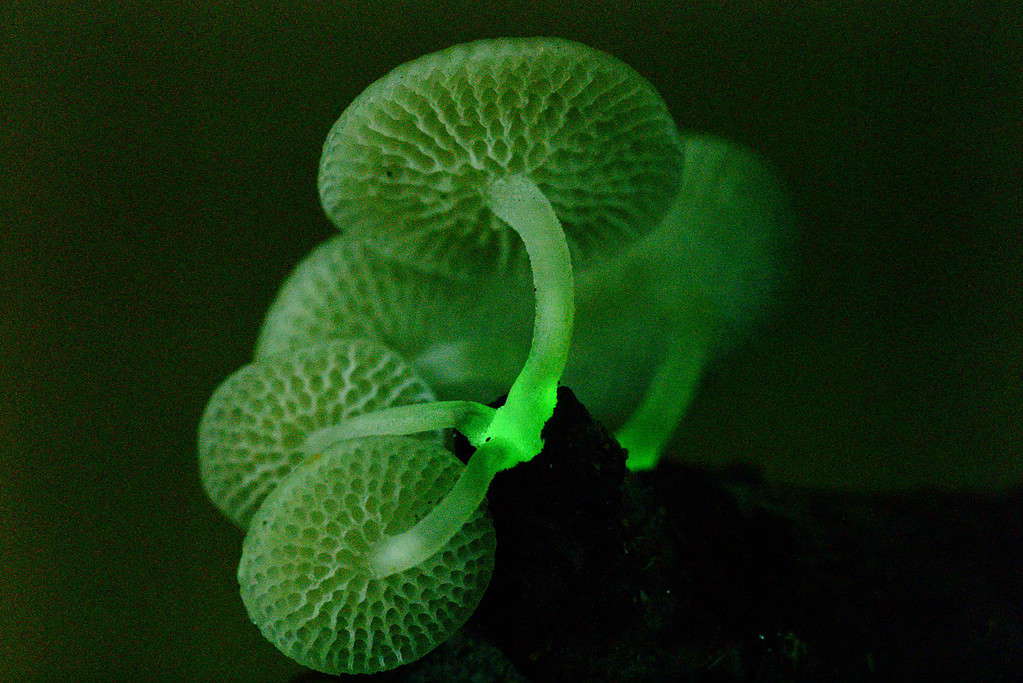
A beautiful pics of Filoboletus manipularis aka the Luminous Porecap glowing
©https://www.inaturalist.org/photos/173187198 / Jie-Hao Ou / https://creativecommons.org/licenses/by/4.0/ – License
2. Eastern Jack-O-Lantern Mushroom (Omphalotus illudens)
Most of the jack-o-lantern mushroom species in the Omphalotus genus, of which there are at least eight described across North America, Europe, and Asia, contain bioluminescent qualities. They are so named for their orange-brown caps and glowing properties.
Omphaltus illudens is the eastern jack-o-lantern species native to eastern North America. At night, you can see a mild green glowing of the gills. This genus is also quite poisonous to people, and ingestion can cause severe cramps, vomiting, diarrhea, nausea, and weakness. If you are a beginner chanterelle forager, make certain that you can distinguish chanterelles from jack-o-lantern mushrooms. Omphalotus subilludens and Omphalotus olivascens are the other orange-capped species native to North America.

only glows when very young and in little ambient lighting.
©Judy M Darby/Shutterstock.com
3. Luminescent Panellus (Panellus stipticus)
Luminescent panellus (Panellus stipticus), also known as bitter oyster, is a bioluminescent mushroom commonly occurring across Australia, Asia, Europe, and North America. They fruit in shelving clusters on dead hardwood. At night, the clusters of gills glow brightly, putting on quite an eerily beautiful show. In warmer parts of their range, these mushrooms can occur year-round. Otherwise, they fruit from spring through fall. Especially in eastern North America, if you take a night-time walk through forested hardwood areas you may be lucky enough to witness their beautiful glow.

looks beautiful during the day and at night.
©bob.leccinum.Robert Kozak/Shutterstock.com
4. Mushrooms that Glow in the Dark: Mycena singeri
Mycena singeri, which does not yet have a common name, is a species in the Mycenaceae family of delicate, white-spored saprobic mushrooms. Many Mycena mushrooms have bioluminescent qualities, including Mycena singeri. Growing singularly or in small clusters on rotting hardwood logs, this little mushroom features umbrella-shaped caps and sparsely spaced, prominent gills. At night, Mycena singeri, found in lowland forests of South America, emits a lovely green glow from its stipe and gills. Younger specimens are more likely to feature bioluminescence.
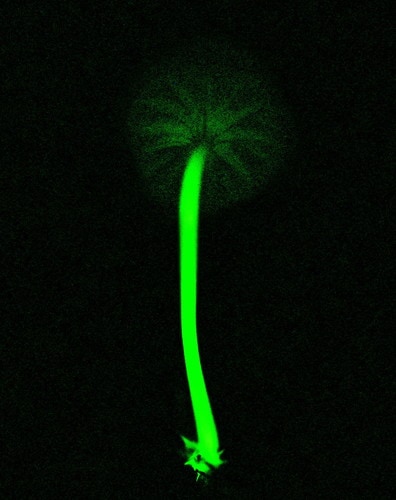
Mycena singeri, a rare mushroom to find or photograph
©https://www.inaturalist.org/photos/102369315 / Alan Rockefeller / https://creativecommons.org/licenses/by/4.0/ – License
5. Lemon Honeycap (Armillaria limonea)
Belonging to the Armillaria genus, aka the honey mushrooms, the lemon honeycap (Armillaria limonea) emits bioluminescence from its gills. Like other species in its genus, the lemon honeycap exhibits both a parasitic and saprobic phase. This species is native to New Zealand. It fruits during fall in tight clusters from rotting stumps, bases of trees, and buried wood. When young, this species has a partial veil covering its gills. So, to best view the glowing gills, keep an eye out for older specimens with opened caps.
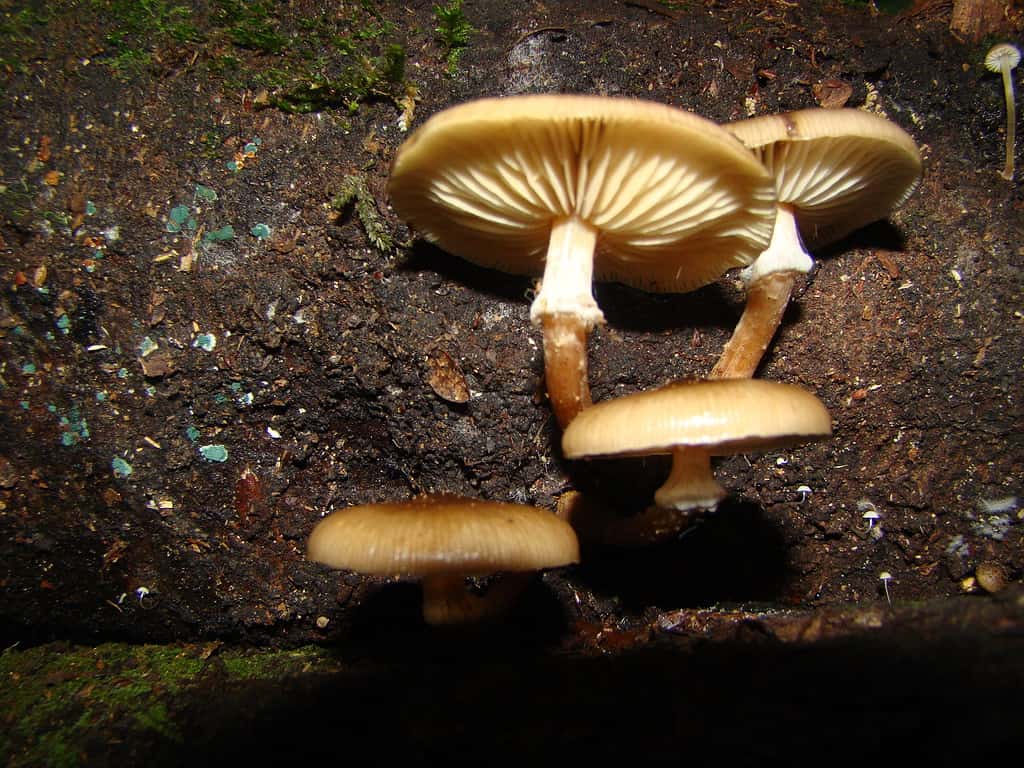
Armillaria limonea is a beautiful parasitic mushroom.
©https://www.inaturalist.org/photos/102242236 / Lisa Bennett / https://creativecommons.org/licenses/by/4.0/ – License
6. Green Pepe (Mycena chlorophos)
Found in subtropical regions of Asia, the green pepe mushroom (Mycena chlorophos) is one of the more famous glowing mushrooms. Like Mycena singeri, the green pepe mushroom belongs to the most bioluminescent family of mushrooms, Mycenaceae. Fruiting from rotting branches, twigs, and logs in rainy, warm months, Mycena chlorophos puts on a gorgeous display of bioluminescent across the forest floor. The gills of this species glow particularly bright.
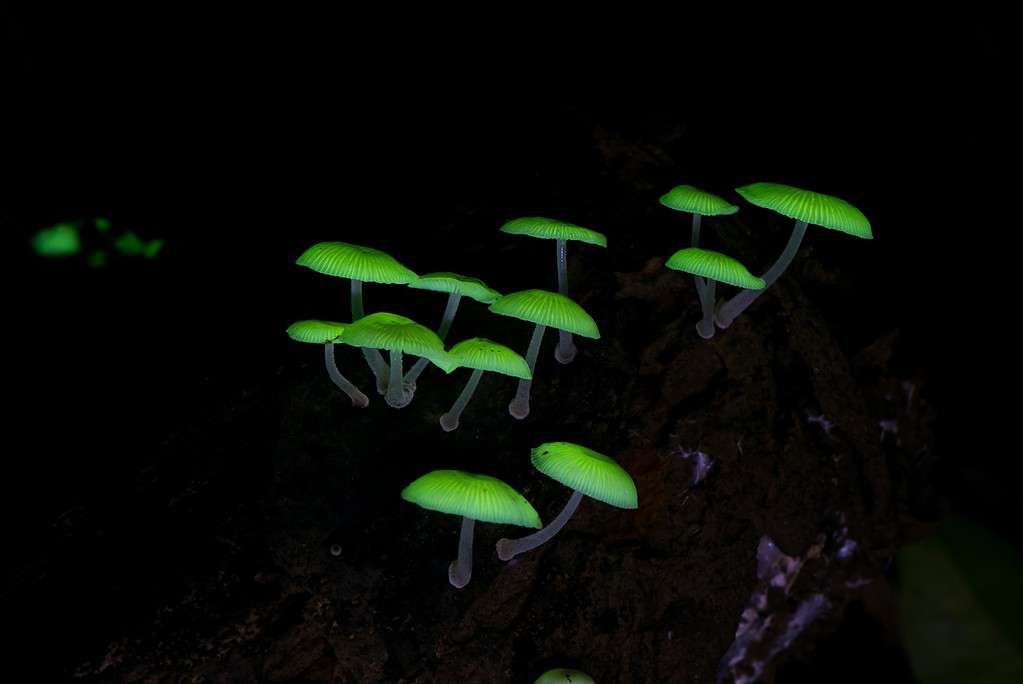
Mycena chlorophos aka green Pepe
©https://www.inaturalist.org/photos/20132808 / Cheng-Tao Lin / https://creativecommons.org/licenses/by/4.0/ – License
7. Gerronema viridilucens
Gerronema viridilucens, is a bioluminescent mushroom, as its scientific species name suggests, occurring across South America, especially in mature forests of Brazil. Fairly inconspicuous during the day, at night clusters of Gerronema viridilucens growing from rotting logs and live bark feature glowing gills. It’s most impressive to view when the cap is upturned.

is one of very few mushrooms from the genus Gerronema that glow.
©https://commons.wikimedia.org/wiki/File:COGUMELOS_BIOLUMINESCENTES_-_Gerronema_viridilucens.jpg / Henrique R. Domingos / https://creativecommons.org/licenses/by-sa/4.0/deed.en – License
8. Mushrooms that Glow in the Dark: Ghost Mushroom (Omphalotus nidiformis)
While the majority of Omphalotus species usually fall under the common name “jack-o-lantern mushroom” for their orange caps, the ghost mushroom (Omphalotus nidiformis) features white gills and caps. Thus, when the gills of this Omphalotus species glows, it produces a wonderfully eerie, ghost-like effect. The ghost mushroom is the species of Omphalotus native to Australia and Tasmania.

A gorgeous pic of one of the more well known luminescent mushrooms
Omphalotus nidiformis,
©Petar B photography/Shutterstock.com
9. Eternal Light Mushroom (Mycena luxaeterna)
The eternal light mushroom (Mycena luxaeterna) is a delightful species in the Mycenaceae family. While the cap is quite typical of mushrooms in the Mycena genus with its fragile, almost translucent parachute cap, the stipe is more unique. The stipes on this mushroom is long and spindly, often growing in serpentine patterns. To add to this interesting feature, the stipe is also the part of the eternal light mushroom that emits bioluminescence.
This extremely rare mushroom is currently only known to exist in a limited region of the Atlantic Coastal Forest of São Paulo, Brazil. There, it these tiny mushrooms grow in clusters from sticks and sometimes leaf litter.

, a rare and beautiful mushroom that glows in the dark.
©https://mushroomobserver.org/images/1034785 / Grant (Grande4231) / https://creativecommons.org/licenses/by-sa/3.0/ – License
10. Little Ping-Pong Bat Mushroom (Panellus pusillus)
Whimsically named the little ping-pong bat mushroom (Panellus pusillus), this species in the Mycenaceae family features glowing pores underneath the cap. The large, prominent pores under the white, oyster-like cap are already eye-catching during the day. At night, their bioluminescent glow only add to their intrigue.
You can find this widely distributed mushroom growing on rotting logs throughout subtropical-tropical, lowland forests of Australia, Asia, North America, South America, and Europe.
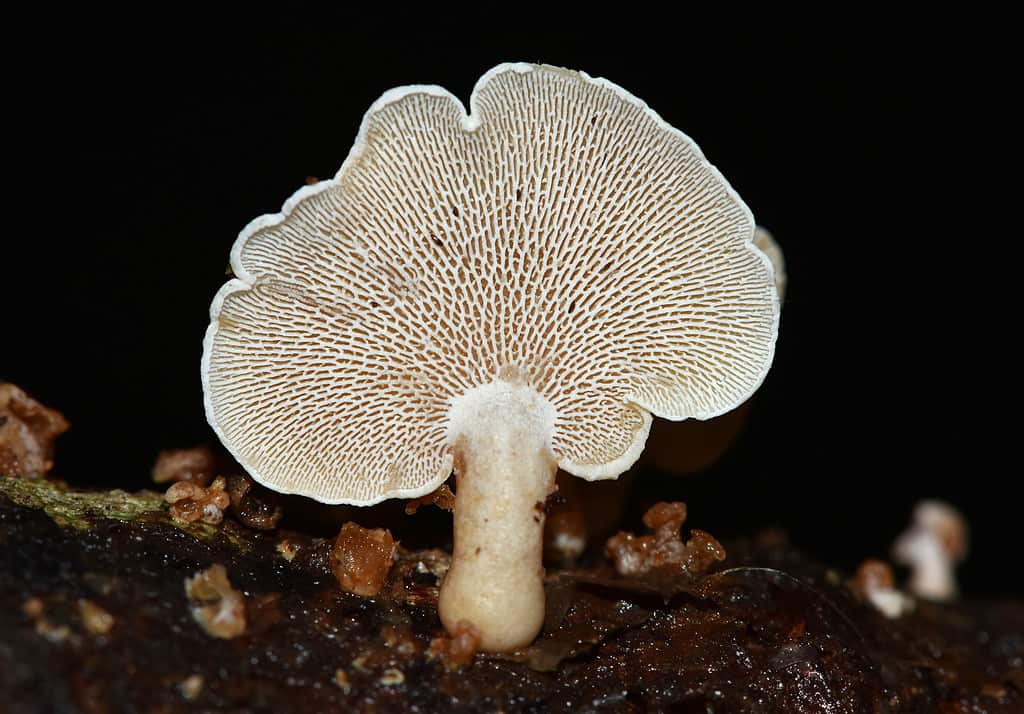
is one of a few mushrooms from this genus that glows in the dark.
©https://www.inaturalist.org/photos/5778016 / Alan Rockefeller / https://creativecommons.org/licenses/by/4.0/ – License
11. Mushrooms that Glow in the Dark: Marsh Honey Fungus (Desarmillaria ectypa)
While the majority of mushrooms in Desarmillaria and Armillaria only have bioluminescent mycelium, the marsh honey fungus (Desarmillaria ectypa) joins the lemon honeycap mushroom in having glowing fruiting bodies. On the marsh honey fungus, the gills produce a soft glow. To add to even more interest, this mushroom only appears in swamp and marsh environments where its glowing gills provide a fairytale-like ambiance. Its range covers wetland environments across parts of Europe and Asia.
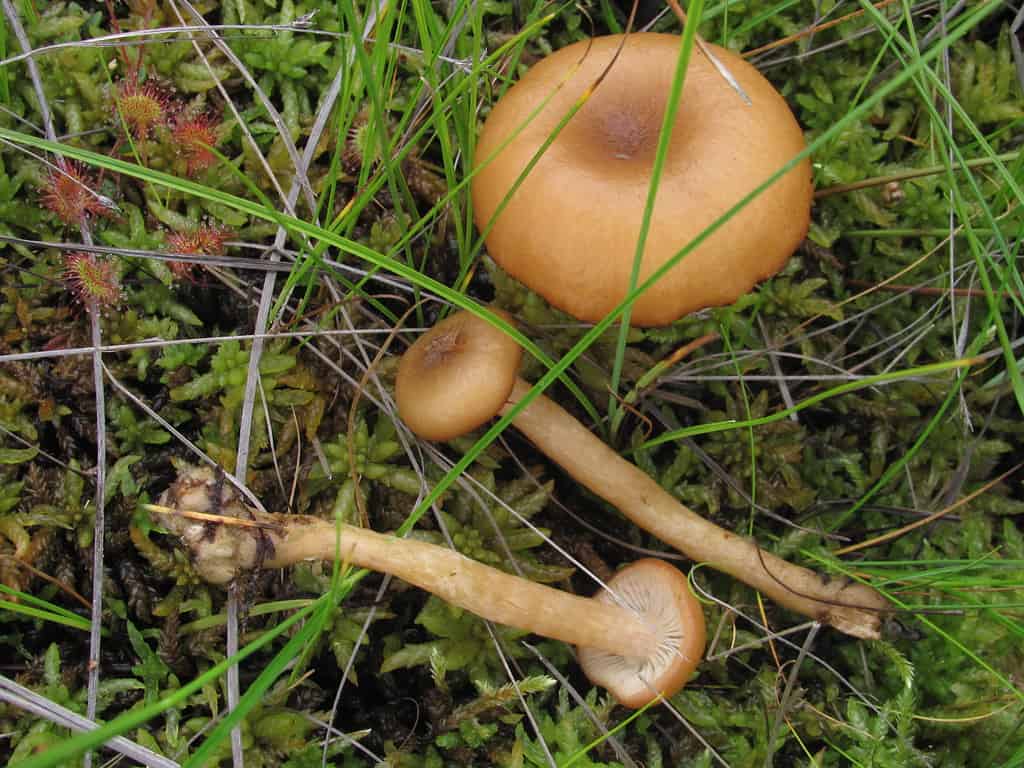
Desrmillaria ectypa is one of the few honey mushrooms that has glowing fruiting bodies.
© https://commons.wikimedia.org/wiki/File:Armillaria_ectypa.jpg / Pärismaalane / https://creativecommons.org/licenses/by-sa/4.0/deed.en – License
| Mushrooms that Glow in the Dark | Name |
|---|---|
| #1 | Luminous Porecap (Filoboletus manipularis) |
| #2 | Eastern Jack-O-Lantern Mushroom (Omphalotus illudens) |
| #3 | Luminescent Panellus (Panellus stipticus) |
| #4 | Mushrooms that Glow in the Dark: Mycena singeri |
| #5 | Lemon Honeycap (Armillaria limonea) |
| #6 | Green Pepe (Mycena chlorophos) |
| #7 | Gerronema viridilucens |
| #8 | Ghost Mushroom (Omphalotus nidiformis) |
| #9 | Eternal Light Mushroom (Mycena luxaeterna) |
| #10 | Little Ping-Pong Bat Mushroom (Panellus pusillus) |
| #11 | Marsh Honey Fungus (Desarmillaria ectypa) |
The photo featured at the top of this post is © Porntip Chaiwat/Shutterstock.com
The information presented on or through the Website is made available solely for general informational purposes. We do not warrant the accuracy, completeness, or usefulness of this information. Any reliance you place on such information is strictly at your own risk. We disclaim all liability and responsibility arising from any reliance placed on such materials by you or any other visitor to the Website, or by anyone who may be informed of any of its contents. None of the statements or claims on the Website should be taken as medical advice, health advice, or as confirmation that a plant, fungus, or other item is safe for consumption or will provide any health benefits. Anyone considering the health benefits of particular plant, fungus, or other item should first consult with a doctor or other medical professional. The statements made within this Website have not been evaluated by the Food and Drug Administration. These statements are not intended to diagnose, treat, cure or prevent any disease.
Thank you for reading! Have some feedback for us? Contact the AZ Animals editorial team.






